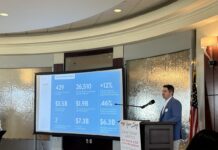ORLANDO, Fla. (June 5, 2024) – With the presidential election just months away, the University of Central Florida’s Sean Snaith is remembering the economic policy of one would-be presidential hopeful.
“The last national politician to make deficit and debt reduction part of their platform was independent candidate H. Ross Perot in 1992, when he talked about the intergenerational unfairness of running up the national debt, which at that time was $4 trillion,” said Snaith, the director of UCF’s Institute for Economic Forecasting.
“Today’s national debt approaching $34.8 trillion would have Perot rolling over in his grave,” said Snaith, whose commentary on the national debt is the focus of his latest quarterly U.S. forecast out today.
“Non-stop, unnecessary deficit spending is not without consequences,” Snaith adds. “The national debt is a budgetary albatross that is restricting our options when it comes to federal spending, and that albatross only gets larger when interest rates rise.”
Since the Federal Reserve’s fight against inflation isn’t over, Snaith says that it’s not beyond the realm of possibility that the Fed may be forced to raise interest rates again, further fueling national spending.
While Snaith doesn’t believe deficit spending will be addressed anytime soon, he does predict a slowing economy is coming.
Here are other highlights from his four-year quarterly U.S. forecast:
- Interest payments on the national debt are now larger than spending on Medicare and national defense. The amount that the projected deficits will add to the national debt over the next four years will be $6.5 trillion, pushing the total national debt to more than $41.2 trillion and a debt-to-GDP ratio of approximately 130%.
- U.S. consumers powered the post-COVID recovery. Following the end of most lockdowns, consumers were ready to spend. High energy prices, food costs and housing costs have steadily eroded their purchasing power. Credit card debt and drawing down savings temporarily patched the hole in their monthly budgets, but this loss of purchasing power has set the table for the economic slowdown that approaches.
- Real consumption spending eased to 2.5% in 2022 due to falling real wages. Spending decelerated to 2.2% in 2023 and will continue to do so until hitting 1.8% in 2025, before rising to 2.0% in 2026 and 2.1% in 2027.
- Core consumer price inflation will continue its slow decline. By the middle of 2027, headline inflation will be close to the Fed’s target level of 2%, but the Fed has signaled that interest rate cuts could happen before this target is reached. This may prove to be a costly mistake.
- Real GDP growth was -2.2% in 2020 but accelerated to 5.8% in 2021. It eased to 1.9% in 2022, before bumping to 2.5% in 2023. From here, it will slow to 2.3% in 2024 and 1.5% in 2025. Then, real GDP growth will drift higher, hitting 1.7% in 2027.
- The housing market remains tight. Soaring prices combined with 7% mortgage rates have eroded demand. However, persistently low inventories will reinforce the sector. Housing starts declined from 1.6 million in 2022 to 1.42 million in 2023 and will slowly ease, reaching 1.39 million in 2026.
- Payroll job growth of 2.4% in 2023 will decelerate steadily starting in 2024, with growth falling to 1.6% and to 0.5% in 2025 before slowing to a trickle in 2026-27.
- Despite resistance to the effects of the Fed tightening thus far, the headline unemployment rate (U-3) is expected to gradually rise from 3.9% to 4.7% in 2027. The resiliency of the labor market has played a large role in keeping a recession at bay.
Sean Snaith, Ph.D., is the director of UCF’s Institute for Economic Forecasting and a nationally recognized economist in the field of economics, forecasting, analysis and market sizing. He has been recognized by Bloomberg News as one of the country’s most accurate economic forecasters and has served as a consultant for both local governments and multi-national corporations. Before joining UCF’s College of Business, Snaith held faculty positions at Pennsylvania State University, American University in Cairo, the University of North Dakota and the University of the Pacific. More of Snaith’s work is available at http://iec.ucf.edu or you can follow him @SeanSnaith.











































